Introduction
Tattoos have become a popular form of self-expression, and the art of tattooing has evolved significantly over the years. Understanding the different components of a tattoo machine is essential for both tattoo artists and enthusiasts alike. In this comprehensive guide, we will delve into the world of tattoo machine parts and provide you with a detailed understanding of each component. Whether you’re considering getting a tattoo or simply want to expand your knowledge, this guide will equip you with the necessary insights. So, let’s explore the essential tattoo machine parts together.
Tattoo Machine Parts/Components
So, Generally tattoo machines consist of several key components that work together to create stunning tattoos. Each component plays a vital role in the machine’s functionality and ensures the tattoo artist can deliver their artistic vision effectively. Let’s explore these components in detail:
| Component | Description |
| Frame | The sturdy structure that holds all the components together. |
| Coils | Electromagnetic coils that provide the power for the machine. |
| Armature Bar | Transfers the motion from the coils to the needle. |
| Front Binding | Secures the armature bar and provides stability. |
| Rear Binding | Stabilizes the back end of the armature bar. |
| Springs | Assist in the movement of the armature bar. |
| Contact Screw | Controls the machine’s contact with the circuit. |
| Capacitor | Stores electrical energy and helps regulate the machine’s power. |
| Tube and Grip | Holds the needle and provides a comfortable grip for the artist. |
| Needle | Carries the ink and creates the tattoo. |
| Tube Vice | Holds the tube securely in place. |
| Rubber Bands | Control the machine’s give and tension. |
| Power Supply | Provides the electricity needed to run the machine. |
| Foot Pedal | Controls the machine’s power supply. |
| Clip Cord | Connects the machine to the power supply. |
| Ink Reservoir | Holds the ink and allows for easy access during tattooing. |
| O-rings | Provide cushioning and stability for various components. |
| Armature Bar Nipple | Attaches the needle to the armature bar. |
| Washers | Add stability and prevent friction between components. |
| Grommet | Acts as a cushion between the front binding and armature bar. |
| Rubber Nipple | Protects the needle and ensures smooth movement. |
| Machine Bag | Protects the machine from contaminants and provides hygiene. |
| Machine Grip | Provides a comfortable and ergonomic grip for the artist. |
| Machine Casing | Encloses the machine and protects the internal components. |
| Machine Screws | Securely fasten the different components of the machine. |
Explained in Detail about all key components of Tattoo Machine
Tattoo Machine Frame
The tattoo machine frame serves as the foundation and structure for the entire machine. It holds all the components together and provides stability during the tattooing process. Tattoo machine frames can be made of various materials, including steel, aluminum, or even plastic. The frame design may vary depending on the type of machine, such as rotary or coil machines.
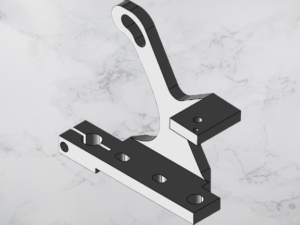
Coils
Coils are an essential part of the tattoo machine as they provide the power needed for tattooing. They are electromagnetic and work on the principle of electromagnetism. When electric current passes through the coils, they create a magnetic field that moves the armature bar.
Armature Bar
The armature bar is responsible for translating the motion created by the coils into a vertical motion that drives the needle. When the coils generate the magnetic field, it attracts or repels the armature bar, creating the up and down motion necessary for tattooing.

Front Binding
The front binding is a component that secures the armature bar and provides stability during the tattooing process. It ensures that the armature bar moves smoothly without any wobbling, allowing for precise control over the needle.
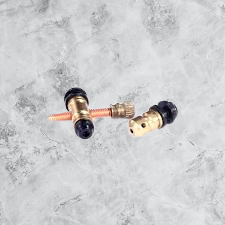
Rear Binding
Similar to the front binding, the rear binding stabilizes the back end of the armature bar, ensuring smooth movement and reducing vibrations. It helps maintain consistent needle depth during the tattooing process.
Springs
Springs play a crucial role in the movement of the armature bar. They assist in the up and down motion, providing the necessary tension and rebound for proper needle control. Different types of springs are available, each offering a unique feel and response.
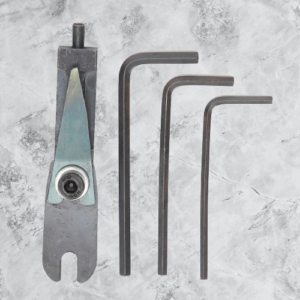
Contact Screw
The contact screw controls the machine’s contact with the circuit. By adjusting the contact screw’s position, the tattoo artist can regulate the machine’s performance, such as its speed and hit. It allows for fine-tuning to achieve the desired tattooing effect.

Capacitor
The capacitor stores electrical energy and helps regulate the machine’s power supply. It ensures a consistent flow of current, preventing fluctuations that could affect the tattooing process. Capacitors are available in various sizes, providing different levels of power stability.
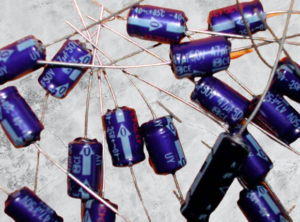
Tube and Grip
The tube and grip combination holds the needle and provides a comfortable grip for the tattoo artist. The tube allows ink flow to the needle, while the grip offers ergonomic support and control during the tattooing process
Needle
The needle is a critical component responsible for creating the tattoo. It carries the ink from the reservoir to the skin, depositing it in the desired pattern. Needles come in different configurations, such as liners, shaders, and magnums, each suited for specific tattooing techniques.
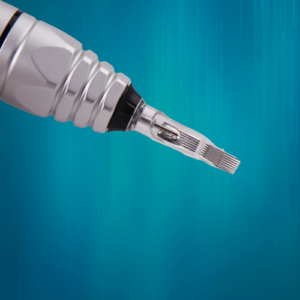
Tube Vice
The tube vice secures the tube tightly in place, ensuring stability and preventing unnecessary movement. It allows for easy adjustment and changing of tubes to accommodate different needle sizes and configurations.
Rubber Bands
Rubber bands play a vital role in controlling the machine’s give and tension. They provide the necessary resistance to ensure the needle returns to its original position after each stroke. Properly adjusted rubber bands contribute to consistent and clean tattooing.

Power Supply
The power supply is responsible for providing the electrical energy needed to run the tattoo machine. It converts the incoming voltage into a stable and regulated current suitable for tattooing. Modern power supplies offer various features like voltage control and digital displays for precise adjustments.
Foot Pedal
The foot pedal serves as the switch to control the tattoo machine’s power supply. By pressing on the foot pedal, the tattoo artist can activate or deactivate the machine, providing hands-free control during the tattooing process.
Clip Cord
The clip cord connects the tattoo machine to the power supply. It allows the electrical current to flow from the power supply through the clip cord and into the tattoo machine, powering its operation. The clip cord should be securely connected to ensure uninterrupted power transmission.
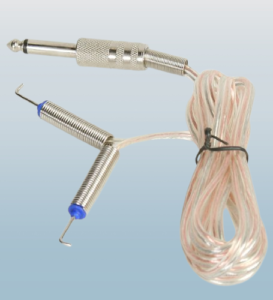
Ink Reservoir
The ink reservoir holds the tattoo ink and provides easy access for the tattoo artist during the tattooing process. It allows for dipping the needle into the ink, ensuring a steady flow and preventing the need for frequent ink replenishment.
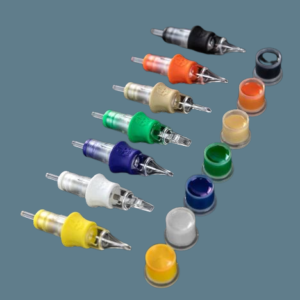
O-rings
O-rings are small rubber rings that provide cushioning and stability for various components of the tattoo machine. They are often found between the frame and the coil, preventing unnecessary vibrations and ensuring smooth operation.
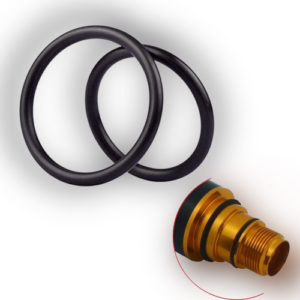
Armature Bar Nipple
The armature bar nipple attaches the needle to the armature bar securely. It allows for easy needle replacement and ensures that the needle stays in place during the tattooing process.
Washers
Washers are essential components that add stability and prevent friction between different machine parts. They are typically placed between the frame and other components to reduce wear and tear and ensure smooth movement.

Grommet
The grommet acts as a cushion between the front binding and the armature bar. It helps absorb vibrations and provides stability during the tattooing process, contributing to smoother and more controlled movements.
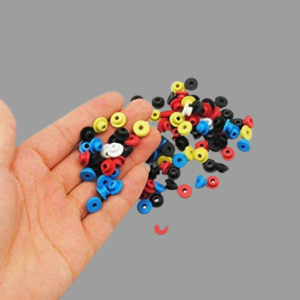
Rubber Nipple
The rubber nipple protects the needle and ensures smooth movement during the tattooing process. It acts as a cushion between the needle and the armature bar, reducing friction and enhancing the machine’s overall performance.
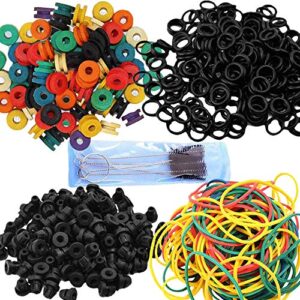
Machine Bag
A machine bag is used to protect the tattoo machine from contaminants and maintain hygiene standards. It covers the entire machine, providing a barrier against dirt, dust, and other external elements that could compromise the tattooing process.
Machine Grip
The machine grip is an essential component that provides a comfortable and ergonomic grip for the tattoo artist. It allows for better control and reduces hand fatigue during long tattooing sessions. Machine grips are available in various materials and shapes to suit individual preferences.
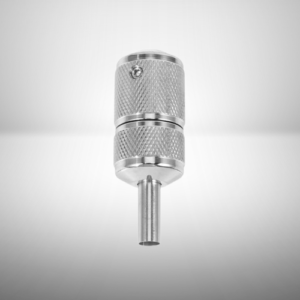
Machine Casing
The machine casing encloses the tattoo machine’s internal components, providing protection and ensuring their proper alignment. It also contributes to the overall aesthetics of the machine, allowing artists to express their personal style.
Machine Screws
Machine screws are used to securely fasten the different components of the tattoo machine. They ensure that all parts are tightly connected, reducing the risk of any loose components affecting the tattooing process.

Adjusting the Tattoo Machine
Tattoo machines require occasional adjustments to ensure optimal performance. Artists can adjust various components, such as the contact screw, front and back springs, and needle depth, to achieve the desired tattooing results. Proper adjustment and fine-tuning allow artists to customize their machines for different tattooing techniques and styles.
Maintaining and Cleaning the Tattoo Machine
Regular maintenance and cleaning are crucial for keeping a tattoo machine in top condition. Artists should clean their machines after each use to remove ink residue, blood, and other debris. Disassembling the machine and cleaning each component individually ensures proper hygiene and extends the machine’s lifespan. Additionally, lubrication should be applied periodically to prevent rust and ensure smooth operation.
Safety Precautions
Tattooing involves working with needles and electrical equipment, making safety precautions paramount. Tattoo artists must follow strict hygiene practices, such as wearing gloves and using disposable materials. Proper disposal of needles and other sharp objects is essential to prevent the spread of infections. Additionally, artists should maintain a clean and sterile workspace and adhere to local health and safety regulations.
Common Tattoo Machine Problems
Despite their mechanical simplicity, tattoo machines can encounter various issues. Some common problems include needle sticking, machine overheating, inconsistent performance, and excessive noise. Understanding these issues and their potential causes can help artists troubleshoot and resolve problems effectively.
Frequently Asked Questions (FAQs)
A tattoo machine works by using electromagnetic coils to create mechanical motion. The coils are powered by an electrical current, which moves the armature bar up and down. The motion of the armature bar then drives the needle, allowing the tattoo artist to create the desired design on the skin.
Yes, many tattoo machine parts can be replaced or upgraded. Artists often customize their machines to suit their preferences and techniques. However, it’s important to ensure compatibility and proper installation to maintain the machine’s functionality and safety.
It is possible to assemble your own tattoo machine; however, it requires a deep understanding of the machine’s mechanics and components. For safety and performance reasons, it’s recommended to rely on professional tattoo machine manufacturers or experienced professionals when acquiring or assembling a tattoo machine.
Yes, tattoo machines can be adjusted and customized to accommodate different tattooing styles. Artists can modify components such as the contact screw, springs, and needle depth to achieve their desired results.
While some components, like tubes and grips, can be interchanged to accommodate different needle sizes and configurations, not all components are universally interchangeable. It’s important to ensure compatibility between the various components to maintain the machine’s functionality and performance.
Conclusion
Understanding the essential tattoo machine components is crucial for both tattoo artists and individuals interested in getting tattoos. Each component has a specific function and contributes to the overall performance and outcome of the tattoo machine. By familiarizing yourself with these components, you can gain a deeper appreciation for the tattooing process and make informed decisions when it comes to tattoo machine selection, customization, and maintenance.
